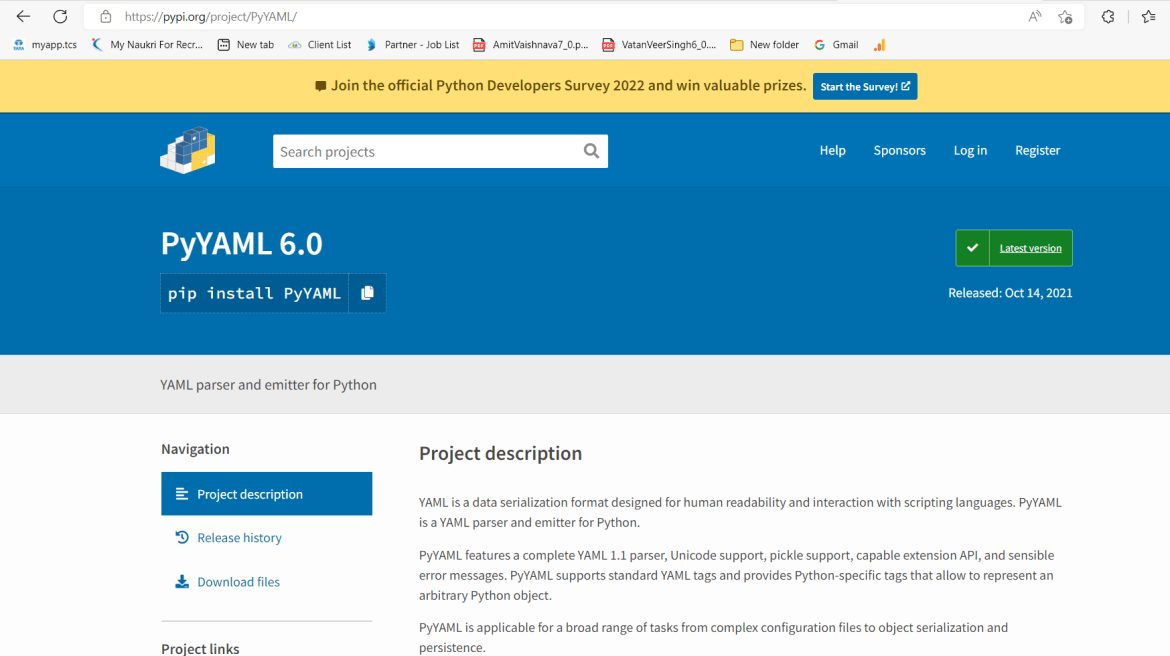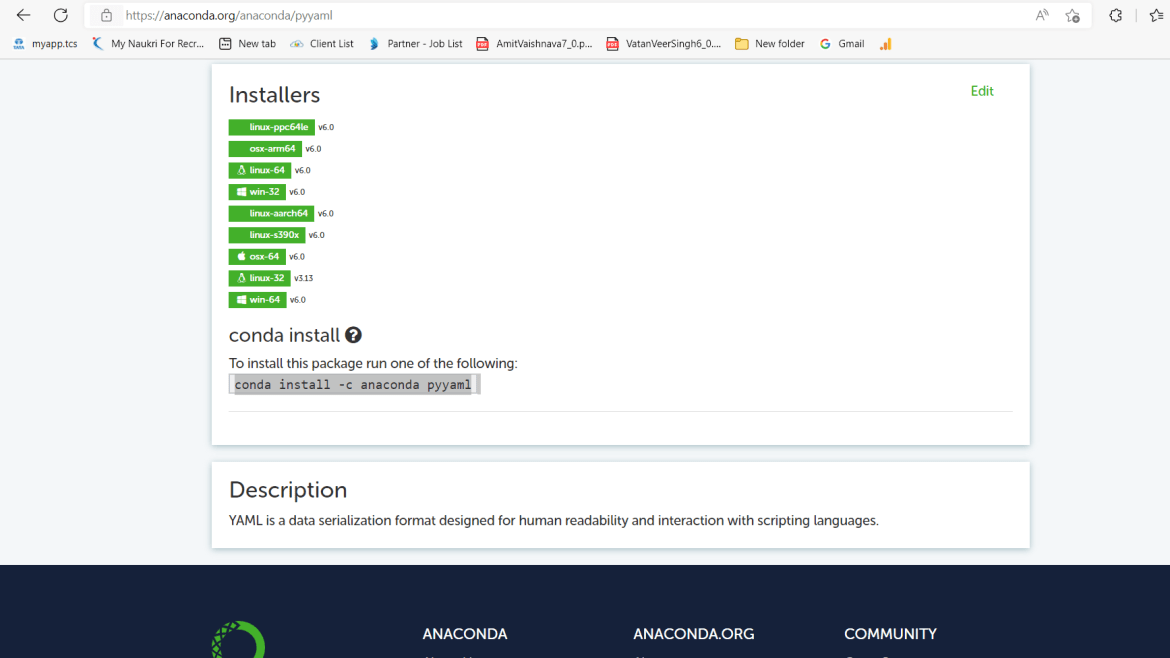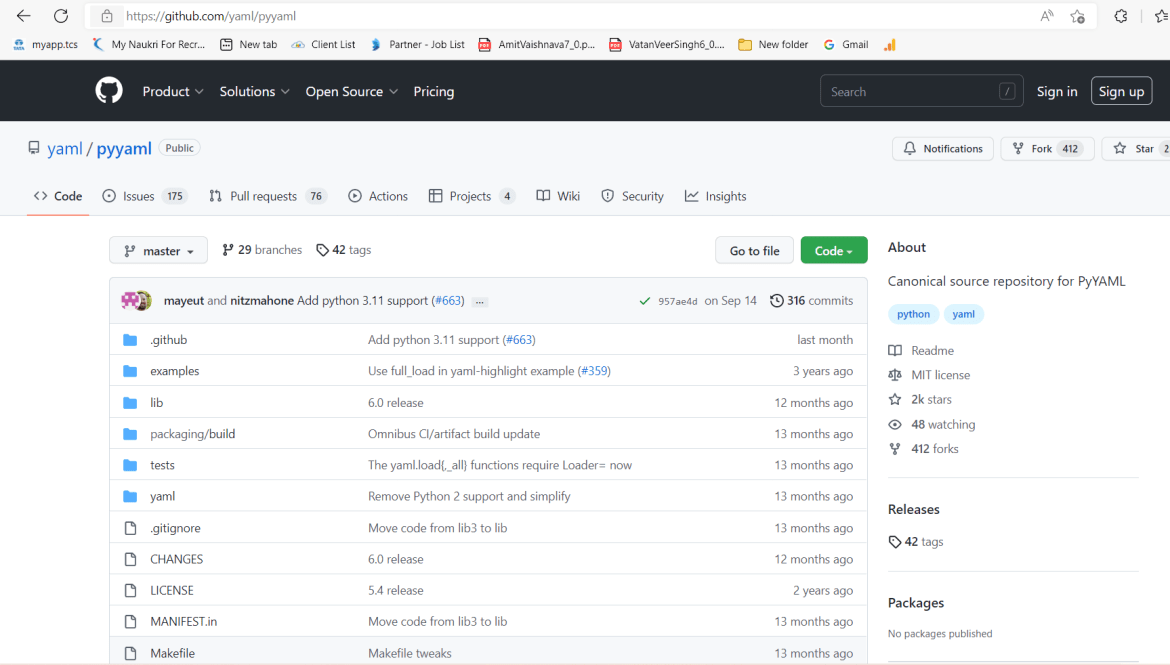A common error you may encounter when using Python is modulenotfounderror: no module named ‘yaml’.
This error occurs when the Python interpreter cannot detect the PyYAML library in your current environment.
You can install PyYAML in Python 3 with python3 -m pip install pyyaml.
This tutorial goes through the exact steps to troubleshoot this error for the Windows, Mac and Linux operating systems.
Table of contents
- ModuleNotFoundError: no module named ‘yaml’
- What is PyYAML?
- Always Use a Virtual Environment to Install Packages
- How to Install PyYAML on Windows Operating System
- PyYAML installation on Windows Using pip
- How to Install PyYAML on Mac Operating System using pip
- How to Install PyYAML on Linux Operating Systems
- Installing pip for Ubuntu, Debian, and Linux Mint
- Installing pip for CentOS 8 (and newer), Fedora, and Red Hat
- Installing pip for CentOS 6 and 7, and older versions of Red Hat
- Installing pip for Arch Linux and Manjaro
- Installing pip for OpenSUSE
- PyYAML installation on Linux with Pip
- How to Install PyYAML on Windows Operating System
- Installing PyYAML Using Anaconda
- Check PyYAML Version
- Summary
ModuleNotFoundError: no module named ‘yaml’
What is PyYAML?
YAML is a data serialization format designed for human readability and interaction with scripting languages. PyYAML is a YAML parser and emitter for Python.
The simplest way to install PyYAML is to use the package manager for Python called pip. The following installation instructions are for the major Python version 3.
Always Use a Virtual Environment to Install Packages
It is always best to install new libraries within a virtual environment. You should not install anything into your global Python interpreter when you develop locally. You may introduce incompatibilities between packages, or you may break your system if you install an incompatible version of a library that your operating system needs. Using a virtual environment helps compartmentalize your projects and their dependencies. Each project will have its environment with everything the code needs to run. Most ImportErrors and ModuleNotFoundErrors occur due to installing a library for one interpreter and trying to use the library with another interpreter. Using a virtual environment avoids this. In Python, you can use virtual environments and conda environments. We will go through how to install PyYAML with both.
How to Install PyYAML on Windows Operating System
First, you need to download and install Python on your PC. Ensure you select the install launcher for all users and Add Python to PATH checkboxes. The latter ensures the interpreter is in the execution path. Pip is automatically on Windows for Python versions 2.7.9+ and 3.4+.
You can check your Python version with the following command:
python3 --versionYou can install pip on Windows by downloading the installation package, opening the command line and launching the installer. You can install pip via the CMD prompt by running the following command.
python get-pip.pyYou may need to run the command prompt as administrator. Check whether the installation has been successful by typing.
pip --versionPyYAML installation on Windows Using pip
To install PyYAML, first create the virtual environment. The environment can be any name, in this we choose “env”:
virtualenv envYou can activate the environment by typing the command:
envScriptsactivateYou will see “env” in parenthesis next to the command line prompt. You can install PyYAML within the environment by running the following command from the command prompt.
python3 -m pip install pyyamlWe use python -m pip to execute pip using the Python interpreter we specify as Python. Doing this helps avoid ImportError when we try to use a package installed with one version of Python interpreter with a different version. You can use the command which python to determine which Python interpreter you are using.
How to Install PyYAML on Mac Operating System using pip
Open a terminal by pressing command (⌘) + Space Bar to open the Spotlight search. Type in terminal and press enter. To get pip, first ensure you have installed Python3:
python3 --versionPython 3.8.8Download pip by running the following curl command:
curl https://bootstrap.pypa.io/get-pip.py -o get-pip.pyThe curl command allows you to specify a direct download link. Using the -o option sets the name of the downloaded file.
Install pip by running:
python3 get-pip.pyTo install PyYAML, first create the virtual environment:
python3 -m venv envThen activate the environment using:
source env/bin/activate You will see “env” in parenthesis next to the command line prompt. You can install PyYAML within the environment by running the following command from the command prompt.
python3 -m pip install pyyamlHow to Install PyYAML on Linux Operating Systems
All major Linux distributions have Python installed by default. However, you will need to install pip. You can install pip from the terminal, but the installation instructions depend on the Linux distribution you are using. You will need root privileges to install pip. Open a terminal and use the commands relevant to your Linux distribution to install pip.
Installing pip for Ubuntu, Debian, and Linux Mint
sudo apt install python-pip3Installing pip for CentOS 8 (and newer), Fedora, and Red Hat
sudo dnf install python-pip3Installing pip for CentOS 6 and 7, and older versions of Red Hat
sudo yum install epel-release
sudo yum install python-pip3Installing pip for Arch Linux and Manjaro
sudo pacman -S python-pipInstalling pip for OpenSUSE
sudo zypper python3-pipPyYAML installation on Linux with Pip
To install PyYAML, first create the virtual environment:
python3 -m venv envThen activate the environment using:
source env/bin/activate You will see “env” in parenthesis next to the command line prompt. You can install PyYAML within the environment by running the following command from the command prompt.
Once you have activated your virtual environment, you can install PyYAML using:
python3 -m pip install pyyamlInstalling PyYAML Using Anaconda
First, to create a conda environment to install PyYAML.
conda create -n project python=3.6 Then activate the project container. You will see “project” in parentheses next to the command line prompt.
source activate projectNow you’re ready to install PyYAML using conda.
Anaconda is a distribution of Python and R for scientific computing and data science. You can install Anaconda by going to the installation instructions. Once you have installed Anaconda and created your conda environment, you can install PyYAML using the following command:
conda install -c anaconda pyyamlCheck PyYAML Version
Once you have successfully installed PyYAML, you can check its version. If you used pip to install PyYAML, you can use pip show from your terminal.
python3 -m pip show pyyamlName: PyYAML
Version: 5.4.1
Summary: YAML parser and emitter for PythonSecond, within your python program, you can import PyYAML and then reference the __version__ attribute:
import yaml
print(yaml.__version__)5.4.1If you used conda to install PyYAML, you could check the version using the following command:
conda list -f pyyaml# Name Version Build Channel
pyyaml 5.3.1 py36haf1e3a3_1 anacondaSummary
Congratulations on reading to the end of this tutorial. The modulenotfounderror occurs if you misspell the module name, incorrectly point to the module path or do not have the module installed in your Python environment. If you do not have the module installed in your Python environment, you can use pip to install the package. However, you must ensure you have pip installed on your system. You can also install Anaconda on your system and use the conda install command to install PyYAML.
Go to the online courses page on Python to learn more about Python for data science and machine learning.
For further reading on missing modules in Python, go to the article:
- How to Solve Python ModuleNotFoundError: no module named ‘urllib2’.
- How to Solve ModuleNotFoundError: no module named ‘plotly’.
Have fun and happy researching!
Hello Guys, How are you all? Hope You all Are Fine. Today I am Just trying to run my script and I am facing following error ImportError: No module named ‘yaml’ in python. So Here I am Explain to you all the possible solutions here.
Without wasting your time, Let’s start This Article to Solve This Error.
Contents
- How ImportError: No module named ‘yaml’ Error Occurs ?
- How To Solve ImportError: No module named ‘yaml’ Error?
- Solution 1: Install pyyaml
- Solution 2: uninstall and then reinstall pyyaml
- Solution 3 : use virtualenv
- Solution 3: Use this command
- Conclusion
How ImportError: No module named ‘yaml’ Error Occurs ?
I am Just trying to run my script and I am facing following error.
import yaml
ImportError: No module named 'yaml'How To Solve ImportError: No module named ‘yaml’ Error?
- How To Solve ImportError: No module named ‘yaml’ Error ?
To Solve ImportError: No module named ‘yaml’ Error To solve this error all you need to do is just install pyyaml using this command. pip install pyyaml.
- ImportError: No module named ‘yaml’
To Solve ImportError: No module named ‘yaml’ Error To solve this error all you need to do is just install pyyaml using this command. pip install pyyaml.
Solution 1: Install pyyaml
To solve this error all you need to do is just install pyyaml using this command.
pip install pyyamlSolution 2: uninstall and then reinstall pyyaml
First of all you need to uninstall python-yaml and its dependencies with the help of this command.
sudo apt-get remove python3-yaml
sudo apt-get remove --auto-remove python3-yamlThen Just Purge config/data too
sudo apt-get purge python3-yaml
sudo apt-get purge --auto-remove python3-yamlNow reinstal pyyaml
sudo pip3 install pyyamlSolution 3 : use virtualenv
pip3 install virtualenvThen
virtualenv --python=python3 venvNow Activate
source venv/bin/activateinstall pyyaml
pip install pyyamlpython env/common_config/add_imagepullsecret.pySolution 3: Use this command
If you are using pip with python2 then run this command
pip install pyyaml
If you are using Python3 then run this
pip3 install pyyaml
If you are Linux user then run this command.
sudo pip3 install pyyaml
Try this Command for python2
python -m pip install pyyaml
For python3 Run this command.
python3 -m pip install pyyaml
Conda users run this command.
conda install -c conda-forge pyyaml
Conclusion
It’s all About this issue. Hope all solution helped you a lot. Comment below Your thoughts and your queries. Also, Comment below which solution worked for you?
Also, Read
- TypeError: can only concatenate str (not “int”) to str
Modulenotfounderror: no module named ‘yaml’ occurs when pyyaml module is not installed or misconfigured in the current running python interpreter. Since we maintain multiple python versions altogether. Hence installing any required python module is not sufficient. We need to make sure we are installing the package at the right location as well. Suppose you are invoking any python script from any virtual environment but you installed the package globally. It will not work in that scenario and throw a similar kind of error.
Well, we will discuss all these aspects in this article in detail. So let’s start the journey.
Since this error is related to pyyaml package hence the best solution is to install or reinstall it.
Solution 1: Installing pyyaml using pip –
using pip package manager with a single command, we can install any python package which is uploaded in PyPI hub.
For Python 2. X –
pip install pyyamlFor Python 3. X –
pip3 install pyyamlAdditional points –
1. If you want to downgrade or upgrade pyyaml package because of any incompatibility. You can use the same command with the version as well. Please refer to the below example for a better understanding.
pip install PyYAML==5.4.1Here is the version. You can opt for any of the versions on the basis of Pyyaml release history.
2. In case while running the above commands, you are facing an access right issue, add sudo before the command. It actually provides admin access. Please check the below command for reference.
sudo pip3 install pyyaml3. Mostly when we install python, it automatically sets the path for pip but if pip path is not properly configured in the path variable try the below command.
python3 -m pip install pyyamlSolution 2: Installing pyyaml using conda –
It’s the default package manager with Anaconda distribution. It works quite similarly to pip. Here is the command for installation pyyaml conda.
conda install -c anaconda pyyamlSolution 3: Installing pyyaml using setup.py ( Source Code) –
Every binary, executive, or installable file gets generated with source code. This is the most basic way to install or run any python package. The only downside is complexity. It is a bit more complex than above mention ways. Here you need to first download the source code from github. After that, you need to run the setup.py file. For more detailed documentation you will get into the PYYAML github.
python setup.py installEnd Notes :
See it is very important to install the package at the required python interpreter. Especially If you are using a virtual environment then you need to first activate the environment and install the package.
python3 -m venv venv # creating virtual env
source venv/bin/activate #activation ( Unix and Mac Family OS)
pip install pyyamlOnly command activation will change for windows OS. Here is the required change.
venvScriptsactivate.batAlso, check out the generic reference to fix this error.
Modulenotfounderror no module named X : Generic Solution
Thanks
Data Science Learner Team
Join our list
Subscribe to our mailing list and get interesting stuff and updates to your email inbox.
We respect your privacy and take protecting it seriously
Thank you for signup. A Confirmation Email has been sent to your Email Address.
Something went wrong.




